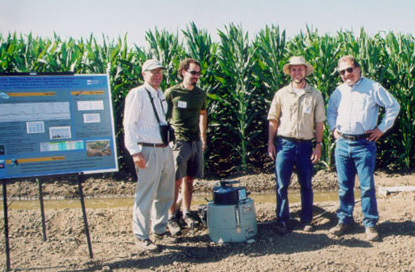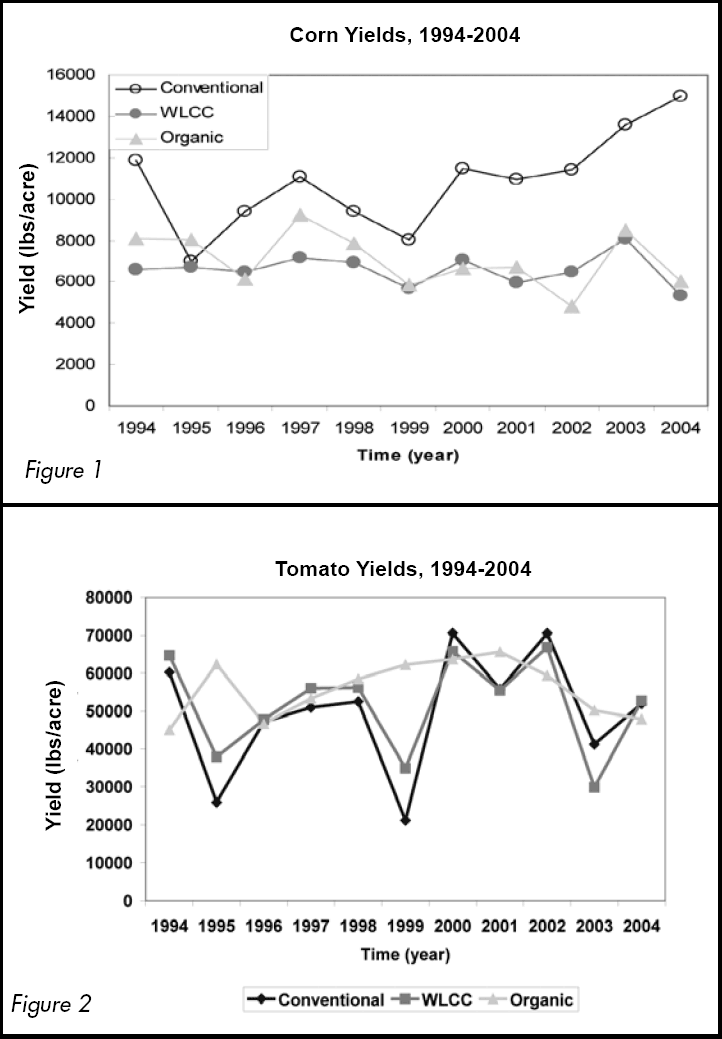|
Winter/Spring 2006 - Vol. 6/No. 2
Long-term comparison of yield and nitrogen use in organic,
winter legume cover crop and conventional farming systems
By Kathleen M. Reed, William R. Horwath, Steve Kaffka, R. Ford Denison, Dennis Bryant, and Z. Kabir

Eleven years of data comparing nitrogen at UC
Davis’ sustainable ag research site is now available. Researchers (from left to right)
Wes Wallender, Sam Prentice, Aaron Ristow and Will Horwath are pictured
at the site. (photo by Lyra Halprin)
|
|
We have recently analyzed 11-years of data comparing nitrogen use in the
organic, winter legume cover crop (WLCC), and conventional farming systems
at a field research site for sustainable agriculture at UC Davis, the
Center for Integrated Farming Systems (CIFS). This article outlines results
from a study at the CIFS site comparing three tomato/corn cropping systems
for yield and N uptake from 1994 to 2004, and suggests possible reasons for
yield differences among farming systems. CIFS represents the merger of the
Sustainable Agriculture Farming Systems (SAFS) project, which began in 1988,
and the Long Term Research on Agriculture Systems (LTRAS) project, which
began in 1991. The former SAFS site was designed to introduce crop diversity
and winter cover crops into rotations, with a specific emphasis on the
conversion from conventional to low-input and organic systems. The goals of
LTRAS have been to evaluate the effects of differing amounts of fertilizer,
organic matter and irrigation on the longterm capacity to sustain or improve
crop yields and related environmental properties. Cropping systems in this
study are designed to reflect this research purpose rather than as models for
commercial farmers.
Yield and N Uptake
Corn

Corn yields across all systems ranged from 4,823 to 14,966 lbs/acre
(standardized to 15.5% moisture). Conventional yields were highest in 1994
and lowest in 1995 and 1999, when conventional planting dates were delayed
and corresponded with the organic and WLCC systems (Fig. 1). Organic corn
yield was lowest in 2002 (4,823 lbs/acre). However WLCC corn yields were
lowest in 2004 (5325 lbs/acre), while in the same year conventional yields
of 14,966 lbs/acre were the highest ever observed in the trial. One reason
for low yields that year in the WLCC system may be that the only N input to
corn and the prior tomato crop was from the previous winter’s cover crops.
Previously, the tomato phase of this cropping system had been fertilized.
Plant N uptake was correlated with corn yields. Conventional yield and N
uptake varied from year to year from 1993 to 2004, while organic and WLCC
yields and N uptake decreased over the last six years remaining low or
declined. In this experiment, cropping systems are compared, so conventional
corn tends to be planted several weeks to a month earlier than the other
systems, which must accumulate cover-crop biomass in the spring. In the
organic and WLCC systems, planting must be delayed until after the
incorporation of fresh organic matter. Earlier planting tends to result in
higher yields. This may not be the only cause of yield differences. In
another study at the CIFS site starting in 2005, fertilizing the WLCC system
with the later planting dates has increased yields (data not shown) comparable
to the conventional system, showing that N availability or timing also is a
critical issue affecting maximum yield potential.
Tomato
Tomato yields ranged from 21,178 to 70,538 lbs/acre during the study (Fig. 2).
Average organic and WLCC tomato yields were, for the most part, comparable to the
conventional yields. However, organic yields varied less over the years than
conventional and WLCC yields. Tomato N uptake generally mimicked yields over the
course of this study.
N balance, N storage in soil, and N loss
The N balance from 1994 to 2004 revealed that the organic system had the greatest
cumulative N input and N balance, while the conventional system had the largest
N output in harvested crops. Although the organic system had the greatest
cumulative N input, it also had the lowest N output of all the systems. Soil N
storage was highest in the organic farming system, which was the only system
with an increase in soil N. A buildup of soil organic matter is required to
increase the potential for N mineralization. Despite that increase in soil N and
C, corn yields were consistently lower in the WLCC and organic systems than in
the conventional one and have remained low for the last several years.
| |
Table 1. Cumulative N balance, soil storage
(at 0-30 cm soil depth), and loss for the organic, WLCC, and conventional cropping systems
at CIFS, 1993-2004. |
| Farming System |
N balance
(lbs N/acre)a |
Soil N storage
(lbs N/acre)b |
N loss
(lbs N/acre)c |
| Organic |
2200a |
611a |
1589a |
| WLCC |
516c |
-293b |
809b |
| Conventional |
691b |
-342b |
1033b |
a N balance = total N input – crop removal
b Soil N storage = soil N in 2004 – soil N in 1993
(based on 2005 and estimated 1993 bulk density measurements)
c N loss = N balance – soil N storage
|
|
Comparison among farming systems of total soil N storage at 0-30 cm depth between
1993 and 2004 showed the greatest quantity of N storage in the organic system.
While the organic system accumulated 611 lbs N/acre, soil N storage decreased by
more than 290 lbs N/acre in both the WLCC and conventional systems (Table 1).
The amount of unaccounted N (presumed lost to the atmosphere or groundwater) was
greatest in the organic system (1,589 lbs N/acre), however, N input was also
highest in this system. There were also large amounts of unaccounted N in the
conventional and WLCC systems, 1,033 and 809 lbs N/acre respectively over the
duration of the study. The organic system lost 72 percent of its 11-year crop N
balance, while storing 28 percent of that N in the soil. However, both the WLCC
and conventional systems lost 100 percent of their 11-year crop N balance and
showed a depletion of soil N. Though the organic system showed a more positive
N balance compared to the other systems, it had an overall greater loss of the
cumulative amount of total N applied during the study. Even though lower amounts
of C and N were added to the organic system after 1997, amounts may still have
been in excess.
The mean balance of soil C over the 11-year study was 8,268 lbs C/acre in the
organic system, 345 lbs C/acre in the WLCC system, and -1,144 lbs C/acre in the
conventional system (data not shown). The organic system may have reached maximum
capacity for N and C storage by 1997, and may have been unable to store
additional N and C in subsequent years. The results indicate that despite large
amounts of C and N applied as manure and cover crops, these soils have a limited
capacity to accumulate organic matter. California’s warm climate, combined with
tillage and irrigation during the warm growing season are probably the primary
reasons for this limitation. However, the initial accumulation of 8.3 tons of C
in the organic system is significant and shows the potential to store C in these
intensively managed systems that include cover crops and manure.
At the former SAFS site prior to 2003, there was a four-year crop rotation of
tomato, safflower, corn, oats/vetch, and beans in the organic, intermediate
(WLCC), and one conventional system, while the other conventional system had a
two-year, two-crop rotation of tomato and wheat. The organic and WLCC systems
at that site had much lower losses over a 10-year period, 80 and 33 lbs N/acre
respectively, compared with the two-year and fouryear conventional systems,
which lost 365 and 403 lbs N/acre respectively. Long-term yields for both corn
and tomato were comparable among all three farming systems at the former SAFS
site, but corn planting in the conventional systems was delayed to correspond to
optimum dates for the organic and WLCC systems.
Over the 11-year study at CIFS, the conventional and WLCC systems lost soil
organic matter, while there was an increase in soil organic matter in the organic
system. The accumulation of N and C in the organic system may improve soil
quality over the long-term, while loss of soil N and C in the conventional system
may decrease long-term soil quality in that system. Soil quality measured in this
way apparently was not correlated with yield over this 11 year period, however.
Low crop diversity may have resulted in negligible C and N gains in the
conventional system despite this system attaining the greatest overall crop yields.
A lower C and N gain in the WLCC systems was most likely attributed to lower corn
yields and correspondingly lower stubble dry matter amounts left in the field
after grain harvest, combined with cover crops planted only every other year only
before corn. In the former SAFS project, N input amounts for some systems were
considerably less than in the LTRAS experiment, which may have contributed to the
lower amounts of unaccounted N. Furthermore, cropping systems used in the former
SAFS project were more diverse than those used in the LTRAS project. These diverse
cropping systems may have also contributed to lower amounts of unaccounted N and
to more positive long-term soil C and N balances at the former SAFS site. In
comparing the SAFS and CIFS studies, the results suggest that future cropping
systems should include diverse crop rotations and winter cover crops.
• Table of Contents •
|
|